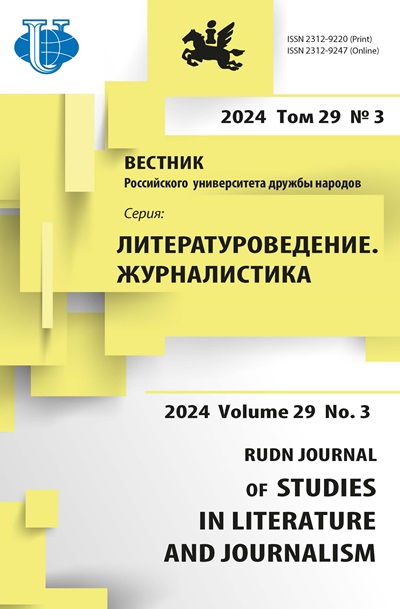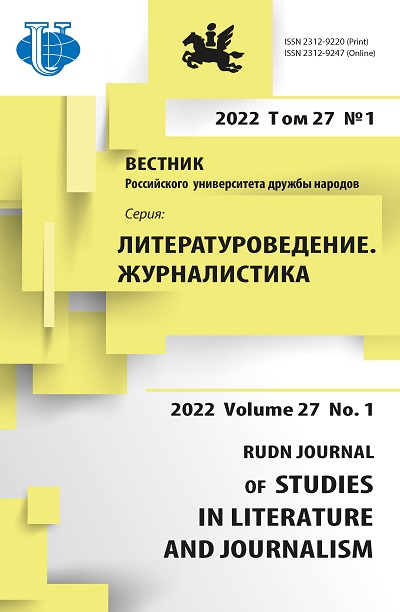Миссия и роль современной журналистики: факторы трансгресcии
- Авторы: Саймонс Г.1,2, Стровский Д.Л.3,4
-
Учреждения:
- Упсальский университет
- Уральский федеральный университет
- Научный центр обороны и коммуникаций при Aриэльском университете
- Институт международных исследований Сычуаньского университета
- Выпуск: Том 27, № 1 (2022)
- Страницы: 109-121
- Раздел: Журналистика
- URL: https://journals.rudn.ru/literary-criticism/article/view/30725
- DOI: https://doi.org/10.22363/2312-9220-2022-27-1-109-121
Цитировать
Полный текст
Аннотация
В данной статье рассматриваются пять актуальных вызовов, которые определяют ситуацию трансформации традиционных профессиональных ориентиров журналистики в контексте трансгрессии, смешения с другими видами информационной деятельности, в частности со связями с общественностью и пропагандой. Прояснение этого вопроса имеет существенное значение не только для решения профессиональных задач в сфере СМИ, но и для определения социальных приоритетов массмедиа. В настоящее время роль и миссия журналистики определяются границами классических постулатов прошлого и парадоксами современных практик, что провоцирует неопределенность и даже противоречия в изучении данной сферы деятельности.
Ключевые слова
Об авторах
Грег Саймонс
Упсальский университет; Уральский федеральный университет
Email: gregmons@yahoo.com
ORCID iD: 0000-0002-6111-5325
доктор философии, доцент, профессор Гуманитарного института Уральского федерального университета (Россия) и Института российских и евроазиатских исследований Университета в г. Упсала (Швеция).
Швеция, Упсала, SE-751 05, P.O. Box 256; Российская Федерация, 620002, Екатеринбург, ул. Мира, 19Дмитрий Леонидович Стровский
Научный центр обороны и коммуникаций при Aриэльском университете; Институт международных исследований Сычуаньского университета
Автор, ответственный за переписку.
Email: dmitry.strovsky@gmail.com
ORCID iD: 0000-0003-1651-2484
профессор, доктор политических наук, исследователь Центра обороны и коммуникаций при Ариэльском университете (Израиль), профессор Института международных исследований Сычуаньского университета (г. Чэнду, Китай).
Израиль, Ариэль, ул. Рамат ХаГолан, 65; Китай, 610065, Чэнду, Южная секция 1б, Джихуан роуд, 24Список литературы
- Azhgikhina, N. (2007). The Struggle for Press Freedom in Russia: Reflections of a Russian Journalist. Europe-Asia Studies, 59(8), 1245-1262.
- Baistow, T. (1985). Fourth-rate Estate: an Anatomy of Fleet Street. London: Comedia.
- Boyatzis, R. (1998). Transforming Qualitative Information: Thematic Analysis and Code Development. Thousand Oaks, CA: Sage.
- Brandzaeg, P.B., Fölstad, A., & Chapparo Dominguez, M.A. (2018). How Journalists and Social Media Users Perceive Online Fact Checking and Verification Services. Journalism Practice, 12(9), 1109-1129.
- Быков А.Ю. Современная зарубежная журналистика: конспект лекций / М-во образования Рос. Федерации. Урал. гос. ун-т им. А.М. Горького. Екатеринбург, 2003 (ОГУП «Полевская тип»).
- Capilla, P. (2021). Post-Truth as a Mutation of Epistemology of Journalism. Media and Communication, 9(1), 313-322.
- Crabtree, B., & Miller, W. (1999). A Template Approach to Text Analysis: Developing and Using Codebooks. In B. Crabtree & W. Miller (Eds.). Doing Qualitative Research. Newbury Park, CA: Sage, 163-177.
- Elliot, V. (2018). Thinking About the Coding Process in Qualitative Data Analysis. The Qualitative Report, 23(11), 2850-2861.
- Erjavec, K. (2004). Beyond Advertising and Journalism: Hybrid Promotional News Discourse. Discourse & Society, 15(5), 553-578.
- Fairfield, J., & Shtein, H. (2014). Big Data, Big Problems: Emerging Issues in the Ethics of Data Science and Journalism. Journal of Mass Media Ethics: Exploring Questions of Media Morality, 29(1), 38-51.
- Franklin, R.A. (2005). McJournalism? The Local Press and the McDonaldization Thesis. In S. Allan (Ed.), Journalism: Critical Issues (pp. 137-150). London: Open University Press.
- Hanusch, F., Banjac, S., & Maares, P. (2020). The Power of Commercial Influences: How Lifestyle Journalists Experience Pressure from Advertising and Public Relations. Journalism Practice, 14(9), 1029-1046.
- Hassid, J. (December 2011). Four Models of the Fourth Estate: A Typology of Contemporary Chinese Journalists. The China Quarterly, (208), 813-832.
- Hellmueller, L., Vos, T.P., & Poepsel, M.A. (2013). Shifting Journalistic Capital? Transparency and Objectivity in the Twenty-First Century. Journalism Studies, 14(3), 287- 304.
- Lewis, J., Williams, A., & Franklin, B.A. (2008). Compromised Fourth Estate? UK News Journalism, Public Relations and News Sources. Journalism Studies, 9(1), 1-20.
- Lippmann, W. (1997). Public Opinion. New York: The Free Press (reprinted from the original of 1922).
- Mancini, P. (2013). Media Fragmentation, Party System and Democracy. The International Journal of Press/Politics, 18(1), 43-60.
- McDowell, W.S. (2011). The Brand Management Crisis Facing the Business of Journalism. The International Journal on Media Management, (13), 37-51.
- Moloney, K., & McGarth, C. (2020). Rethinking Public Relations: Persuasion, Democracy and Society. 3rd ed. Croydon: Routledge.
- Munoz-Torres, J.R. (2012). Truth and Objectivity in Journalism: Anatomy of an Endless Misunderstanding. Journalism Studies, 13(4), 566-582.
- Papathanassopoulos, S. (2020). The Media. In K. Featherstone & D.A. Sotiropoulos (Eds.), The Oxford Handbook of Modern Greek Politics (pp. 412-424). Oxford: Oxford University Press.
- Rice, P., & Ezzy, D. (1999). Qualitative Research Methods: A Health Focus. Melbourne: Oxford University Press.
- Schadewitz, N., & Jachna, T. (2007). Comparing Inductive and Deductive Methodologies for Design Patterns Identification and Articulation. International Design Research Conference IADSR 2007 Emerging Trends in Design Research, 12-15 Nov. Hong Kong.
- Schapals, A.K., & Porlezza, C. (2020). Assistance or Resistance? Evaluating the Intersection of Automated Journalism and Journalistic Role Conceptions. Media and Communication, 8(3), 16-26.
- Schutz, A. (1967). The Phenomenology of the Social World. G. Walsh & F. Lehnert, Trans. Evanston, IL: North Western University Press. (Original German work published 1932).
- Simons, G. (2017). Fake News: As the Problem or a Symptom of a Deeper Problem? Obraz, 4(26), 33-44.
- Simons, G. (2019). The Anatomy of a Moral Panic: Western Mainstream Media’s Russia Scapegoat. Changing Societies and Personalities, 3(3), 189-206.
- Swire, B., Berinsky, A.J., Lewandowsky, S. & Ecker, U.K.H. (2017). Processing political misinformation: Comprehending the Trump phenomenon. Royal Open Society Science, 4(3), 1-21.
- Taylor, P.M. (2003). Munitions of the Mind: A History of Propaganda from the Ancient World to the Present Day. Manchester: Manchester University Press.
- Tumber, H. (2001). Democracy in the Information Age: The Role of the Fourth Estate in Cyberspace. Information, Communication & Society, 4(1), 95-112.
- Webber, F. (2006). Theories of the Information Society. 3rd edition. London & New York: Routledge.
- Zollmann, F. (2017). Bringing Propaganda Back into News Media Studies. Critical Sociology, 1-17.
















